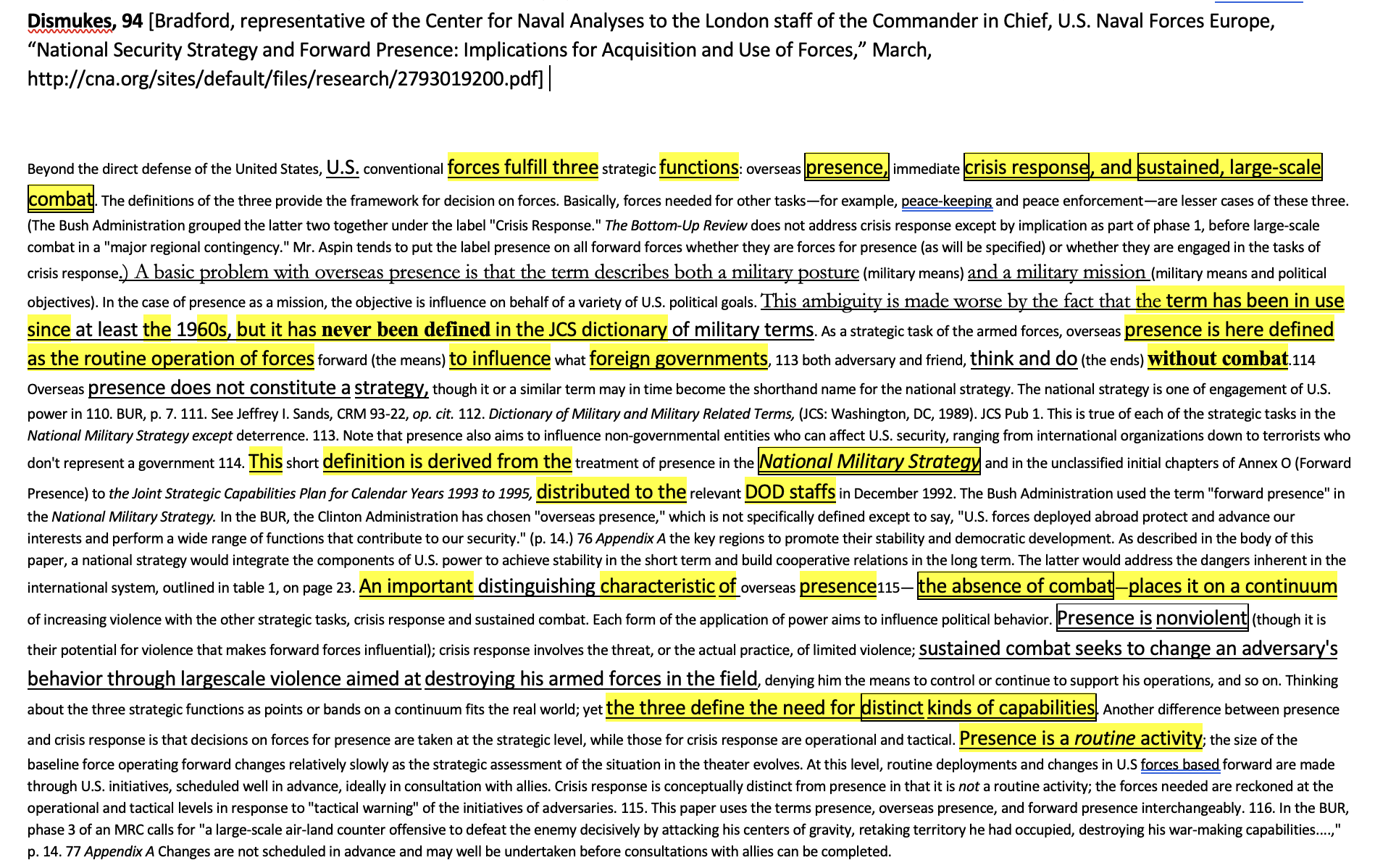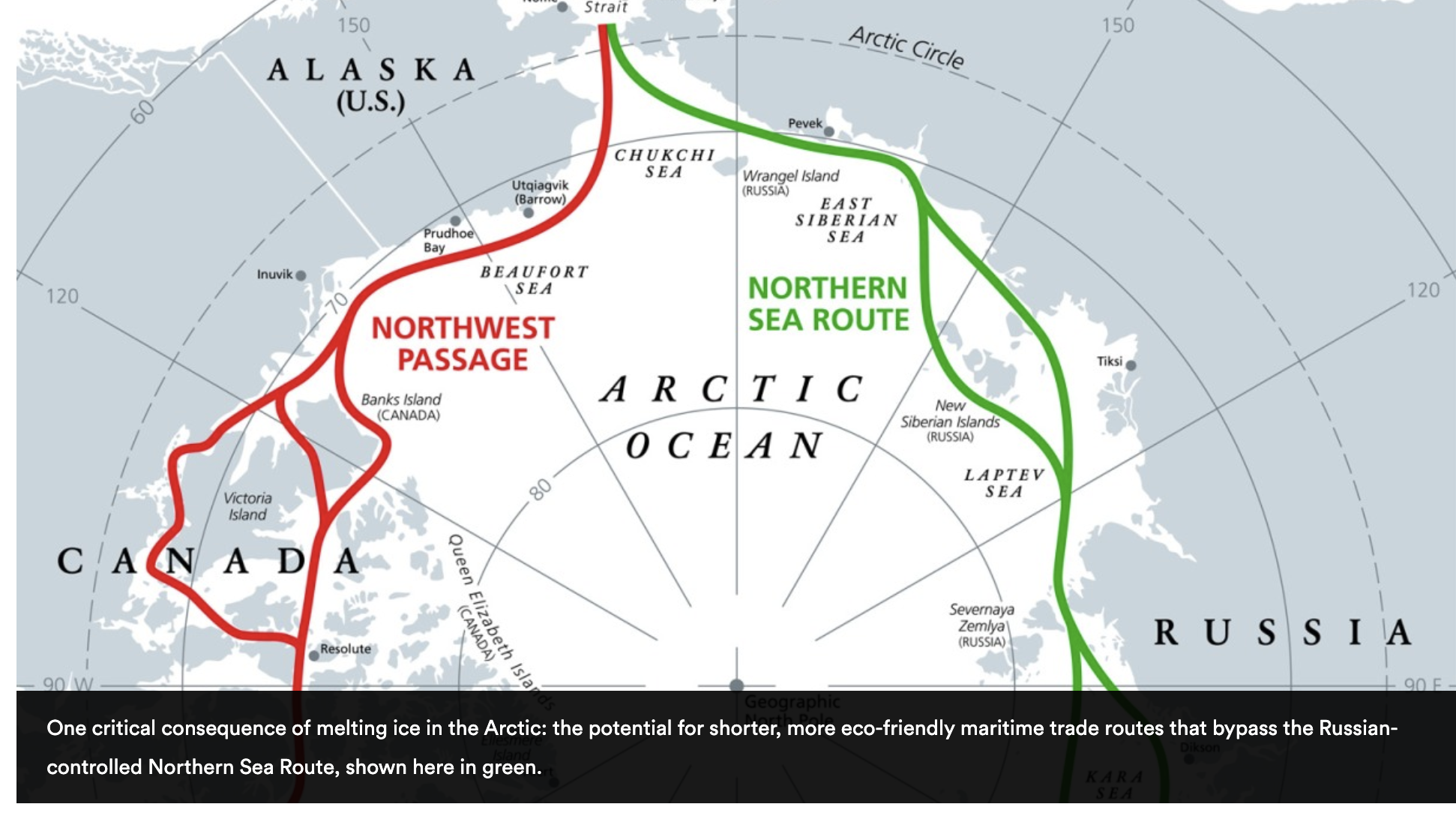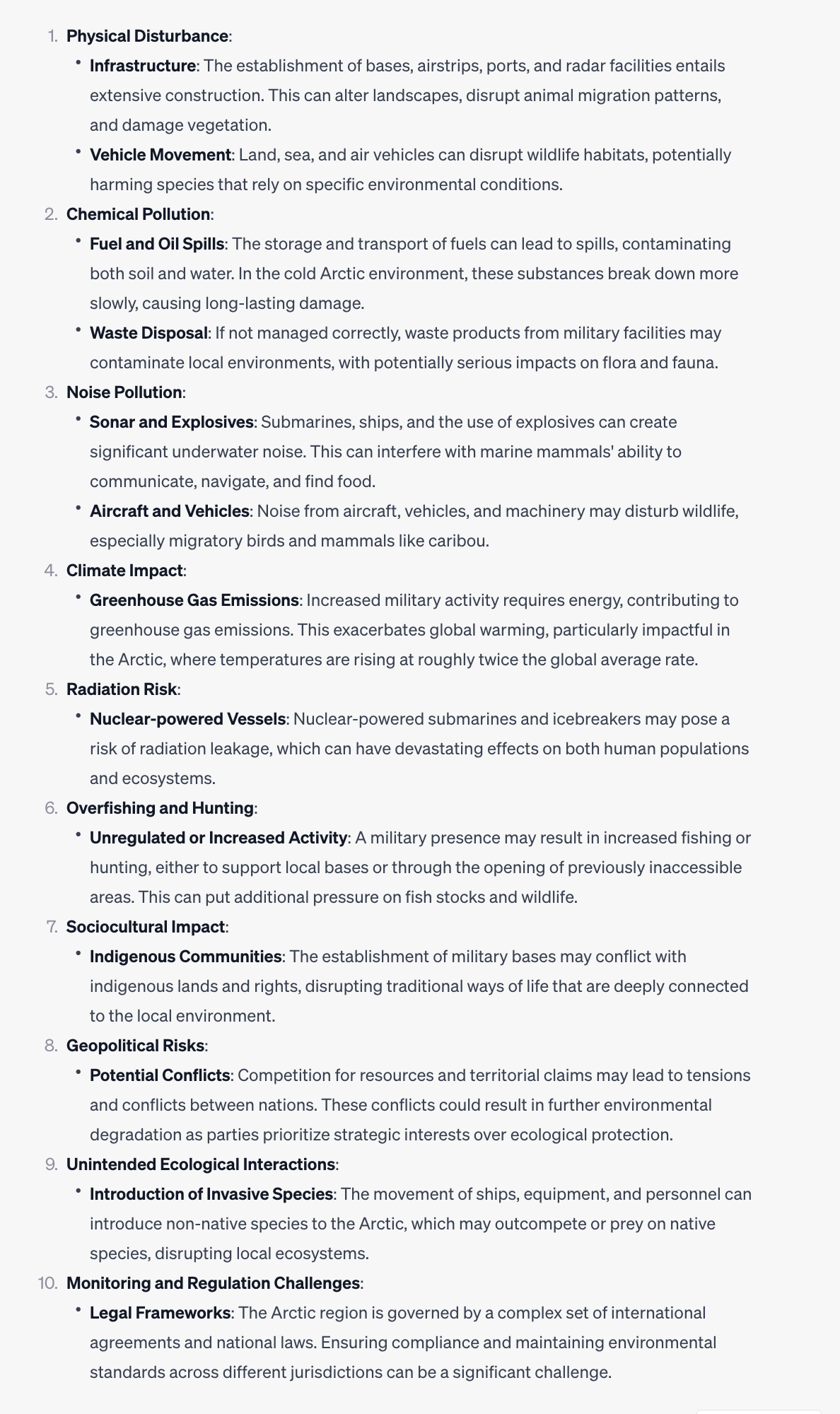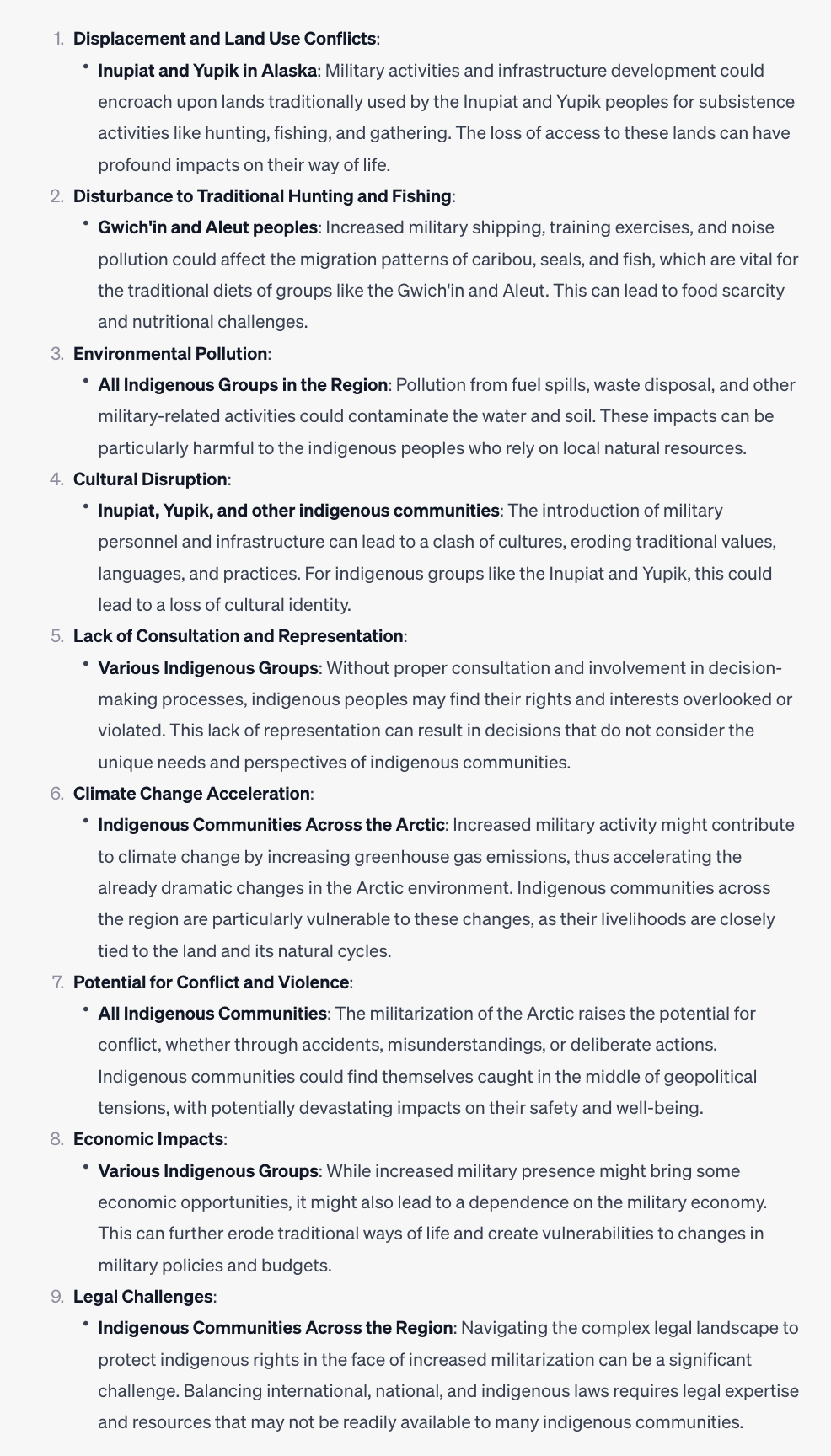Access requires a paid subscription. Year-long (until June 2024) subscriptions are $69 for an individual student and $299 for a school. School subscriptions allow access for 100 users.
Introduction
This resolution asks a simple question – should the United States increase its military presence in the Arctic
In this essay, I will briefly unpack what that means in a bit more detail and examine the major pro and con arguments on the topic.
Terms
The Arctic
The Arctic is a region located at the northernmost part of Earth, encompassing the Arctic Ocean and surrounding lands.
Geographically, the Arctic is often defined as the region within the Arctic Circle, a latitude line located at approximately 66.56°N. This line marks the southernmost point where the sun can remain continuously above or below the horizon for 24 hours during the summer and winter solstices, respectively.
The circle on this InfoPlease map makes it clear what is geographically included in the Arctic and which countries have territory that included in it.
There are additional definitions that will vary slightly that are based on environmental factors (total ice coverage, location of ice coverage, presence of indigenous groups). These definitions are useful for contributing to an understanding of the region, but they aren’t the best for debate purposes because they might vary based on changes in ice coverage or the the location of particular groups.
Given that students in Public Forum debate, students debate the resolution as a whole, I don’t think these definitions will be hotly contested. Pro teams will just generally argue for increasing presence in, “the Arctic.” I simply included the discussion so you are aware of the the different definitions.
Military Presence
The U.S. military presence in the Arctic region involves a complex set of strategic, operational, and environmental considerations.
This quick list of definitions highlights some of the elements.
(1) All instruments of power and their support infrastructure.
(2) The troops do not have be be engaged in combat.
(3) It includes temporary forces (ice cutters that are temporarily in the Arctic, submarines that are temporarily in the Arctic)
(4) It potentially necessitates building bases.
(5) And it includes people
As noted, in Pubic Forum debate the resolution is debated as a whole, so the Pro team will arguably have to defend all of these: deploying troops to newly constructed military bases, as well as any increase in temporary presence of military equipment that passes through the Arctic, including submarines, ice cutters, planes, and other ships.
If the Con teams brings up a problem with increasing any of these in the Arctic, the Pro teams is going to have to defend their increased presence. This is in contrast to Policy debate, and sometimes Lincoln-Douglas debate, where the Affirmative team would argue for a specific increase in presence; for example, they may argue for more ice breakers.
Its
Its is possessive.
So, in this case, it refers to the forces owned and controlled by the US. There is some discussion of NATO forces increasing their presence in the Arctic, and the US is the greatest contributor to NATO, but the forces of other countries are not its forces. Teams can argue whether or not increasing US forces strengthens or harms NATO, but I don’t think they can topically argue that NATO deployment is included with force deployments.
Substantially
Substantially simply means that it has to be a large increase. Since the pro has to defend the whole resolution, and since that includes many military components, this inherently means defending a large increase.
The Pro
With this basic understanding of the topic in mind, let’s look at the Pro.
I think the benefits of increasing US military presence in the Arctic can be divided into three categories.
Security Concerns
There are a number of different security concerns in the Arctic.
Aggression. Security concerns related to aggression primarily concern Russia and China’s growing militarization and influence in the region. There is probably not a high risk of kinetic (physical) military aggression, but Pro teams will argue it is possible and that we need to deter Russia and China. In a more subtle way, Russia and/or China attempt to claim resources or dominate shipping routes.
Terrorism. Terrorists could attack infrastructure in the Arctic.
Cables. The underwater cables that connect the oceans could be cut, disrupting the internet. This could threaten both the US economy and the military.
Related Regions. If China and Russia establish military control of the Arctic, it will be more difficult for the US to supply troops and equipment to Europe in the event of a wider war (beyond the Ukraine). The same is true for Asia in the event of a conflict with China.
Environmental Concerns
There are a number of different environmental concerns related to the Arctic.
Illegal overfishing. Illegal and/or unsustainable overfishing could result in the depletion of fish stocks.
Oil spills. Oil drilling could result in oil spills.
Economic Concerns
Oil. The US needs continued access to oil to power its economy. The Arctic has a lot of it.
Rare earth minerals. Rare earth minerals are needed to produce all types of modern tools, including electric cars, solar PVs, and many other items. The US has good amount of REMS on its own territory, but it is very hard to access these without environmental disruption, forcing the US to rely on China. The Arctic, however, has many of these REMS (though mining them would cause environmental destruction there). We have an entire file on this debate.
Shipping. Melting Arctic ice is creating new shipping routes, and the US military presence is arguably needed to protect those routes, just as it does in the Middle East.
The Con
There are a number of Con arguments that can also be grouped into categories.
Costs
(a) The Expense
Increasing spending by the federal government in a particular area may result in more deficit spending and/or budget trade-offs that impact valuable resources in another area. I’ll talk more about those particular consequences in a bit, but I want to first explain why it would be so expensive to significantly increase military presence.
These are the many ways costs could increase.
Infrastructure Development
Constructing new military bases or expanding existing ones requires significant investment in buildings, facilities, utilities, and infrastructure. Adapting existing ports and airfields or building new ones to accommodate military vessels and aircraft is costly.
Specialized Equipment
Troops need specialized clothing and equipment to operate in the harsh Arctic conditions, adding to the procurement costs. Vehicles, aircraft, and ships must be adapted or specially built to handle extreme cold, ice, and snow, leading to higher manufacturing and maintenance costs.
Operation and Maintenance
Heating and maintaining facilities in extreme cold can be energy-intensive, leading to high ongoing utility bills. The harsh weather conditions mean regular maintenance needs are greater, increasing costs for repairs and upkeep.
Logistical Challenges
The remote location makes supplying bases with food, fuel, and equipment more complex and expensive.
Moving personnel and equipment to and from the Arctic is costly due to the distance and challenging conditions.
Training and Personnel
Troops need specific training to operate in Arctic conditions, requiring additional resources and facilities. Ensuring the well-being and morale of personnel stationed in remote and challenging environments might require additional investment in facilities and support.
Environmental Considerations
Measures to minimize environmental impact (such as oil spill response capabilities) require investment in technology, equipment, and procedures.
Regulatory Compliance: Meeting environmental regulations and standards may necessitate additional investments in technology and oversight.
Communication and Technology
Communication Systems: Establishing robust communication in the Arctic requires investment in specialized technology and infrastructure. Implementing surveillance and monitoring systems adapted to Arctic conditions is an additional expense.
Strategic Assets
Building or retrofitting icebreakers for military use is a significant cost factor, given their specialized nature. Estimates place the cost of icebreakers at $1 billion per icebreaker, though Canada is projecting costs of $7.25 billion to purchase two icebreakers.
Consultation and Coordination
Engaging and consulting with Indigenous communities may require resources for communication, negotiation, and potential compensation.
Given the size of the Arctic all of these costs are likely to be magnified. For example, if the Pro is really going to claim, for example, that the expanded presence of the US military can prevent overfishing, then the military presence will need to be massive. Similarly, if the Pro claims the US presence can stop Russia and China from engaging in military activity all over the Arctic, then that will also require a massive presence.
(b) The Costs — Where Does the Money and Resources Come From?
Increasing military presence in the Arctic could be accomplished by appropriating more money to cover the increased expense of daily operations, building new bases, and purchasing new military equipment. Since the government won’t support a tax increase in the current political environment, this would either have to be funded through deficit spending and/or cuts elsewhere. There is obviously an aversion to deficit spending, so even if there was some deficit spending, that would likely be minimal and there might be cuts.
Where might those cuts occur? It is had to say exactly, but since this would use military resources, it’s possible those military resources would come from elsewhere, such as from East Asia (it seems unlikely we would take resources from Europe right now). This could undermine deterrence vis-a-vis China. If the Pro responds by saying the resources would come from the Middle East, you could say it would undermine deterrence vis-a-vis Iran. Given the massive size of the Arctic and all of the resources that would be required, this is potentially a massive increase in needed resources that would be taken from elsewhere.
Costs could also be absorbed by funding this program instead of some other program the government planned on funding (new aircraft carriers, fighter jets, drones, etc). Con debaters could argue these things are good.
Finally, of course, these costs could be absorbed by cutting (at least partially) social programs.
As long as Con debaters can explain why this would entail significant costs (see above), they will be able to win that there are significant trade-offs.
Encirclement/Isolationism
Increased US military presence in the Arctic could put pressure on Russia and China militarily. In fact, that will be the thesis of many Pro cases.
While this has the potential to enhance deterrence, it also has the potential to threaten Putin (the President of Russia) and Xi (the President of China) politically and to make these countries (especially Russia) insecure militarily.
Why?
The case of Russia is easiest to explain.
As you can see in this diagram, there is a substantial amount of Russian territory in the Arctic.
If the US substantially increases its military presence in the Arctic, especially in areas near Russia, this could make Putin look politically weak. If you are wondering why, imagine that Russia massively increased its military presence near Alaska or off the coast of Florida. Biden would obviously take a lot of political heat for that.
Second, Russia has many nuclear submarines based in the Arctic and relies on those for nuclear deterrence. Why does Russia rely on those for nuclear deterrence if it has thousands of nuclear missiles based on land? To understand this, it is important to understand the basics of the nuclear triad and second strike capability.
The nuclear triad refers to a country’s ability to launch nuclear weapons from three different types of platforms:
Land-Based Missiles: These are missiles that are launched from silos or trucks on land.
Strategic Bombers: These are airplanes specially designed to carry and drop nuclear bombs.
Nuclear Submarines: These are submarines that can launch nuclear missiles from underwater.
Imagine the triad like a three-legged stool. If one leg is damaged, the other two can still support the stool. Similarly, the triad ensures that if one part of the system is attacked or fails, the other two parts can still function.
Second strike capability is like having a backup plan. If a country is attacked with nuclear weapons first, it still has the ability to strike back with its own nuclear weapons. This is crucial because it makes an enemy think twice before attacking, knowing that retaliation is guaranteed. Nuclear deterrence is like a standoff between two people holding water guns. Neither wants to get wet, so they don’t squirt each other. In the world of nuclear weapons, deterrence means that countries are less likely to use their nuclear weapons because they know the other side can strike back. The second strike capability plays a crucial role in this standoff. It’s like having an extra water gun hidden. Even if your opponent squirts you first and you drop your water gun, you can still pull out the hidden one and squirt back.
Now, let’s talk about how nuclear submarines fit into all three parts of this:
Submarines are one of the three “legs” of the nuclear triad. They carry nuclear missiles and can launch them from underwater.
Submarines are stealthy and hard to find. Even if a country’s land-based missiles and bombers are destroyed, the submarines can still strike back. They’re like the hidden water gun in our example.
Knowing that submarines are out there, hidden and ready to strike, adds to the deterrence. It’s like knowing your opponent has not just one, but several hidden water guns. You’re less likely to start squirting if you know they can squirt back, even if you catch them off guard.
What does this have to do with the Arctic?
Russia has a lot of submarines in the Arctic that it relies on for second strike capability. If the US military presence pushes the Russia submarines out of the Arctic and/or allows the US to better know the location of Russian submarines at all times, then the US could target these submarines when conducting a first strike, threatening Russia’s ability to retaliate. Now, you might be thinning that the US would never conduct a nuclear first-strike on Russia. That may be true, but Russia isn’t sure that we would not, just as we can’t be sure that Russia would not attack us.
What might Russia do if Putin is damaged politically and/or its second strike capability is undermined? Well, it might be more aggressive in the Ukraine, including using nuclear weapons there. It might increase its military presence in other parts of the world, including Cuba, which could bring it into conflict with the US. It might try to increase its military presence in the Arctic to offset the US advantage.
Inside Russia, if the military thinks Putin “lost” the Arctic to the US, there may be a greater risk of a coup.
The implications for China are a little less dramatic because while China claims they have interests in the Arctic (and they are obviously interested in the trade routes and resources), they do not have any territory inside the Arctic. Nonetheless, making it more difficult for China to operate in the Arctic (as many Pro teams will claim increasing military presence will accomplish), would hurt China and President Xi may suffer political consequences from that. If Xi is weakened politically, he may try to rebuild his political strength by attacking Taiwan. It might also be more difficult for him to get some economic reform passed that is good.
I want to conclude this section by pointing out that it could also hurt both countries economically. How? Because if the US protects the Arctic in a way that creates specialized protection for its industry, whether it be through protecting specific trade routes or resource access, China and Russia (as well as other countries) could be hurt economically and economic decline in these countries could cause its own set of problems.
Environment
Military activity creates substantial environmental disruption. ChatGPT4 was able to generate a quick list (while these reasons are all true, don’t quote ChatGPT in a debate! These are reasons you should research!
Indigenous Peoples
Again, ChatGPT4 has some good ideas as to how increasing US military presence might threaten indigenous groups.
Again, you should not quote ChatGPT4 in a debate, but obviously it has some good ideas to start. When using AIs like ChatGPT to get you started, it is always especially important to verify facts. These type of AIs are great at providing general explanations and ideas (and those are usually pretty good ideas), but they often get their facts wrong. So in this case, I’d especially check out the indigenous groups referenced to be sure they are actual indigenous groups in the Arctic.
Problems with Basing
In addition to the threats military presence and basing poses to the environment and indigenous groups, bases have also been proven to be hostile places for women, both those living on the base and any “locals” near the bases. They have often been the victims of all types of physical aggression by men (I’m being a bit deliberately vague so as to not get this page blocked by a school filter, but I think you can see what I’m getting at). This has been a common argument on many previous topics.
Hegemony Bad
In policy debate, there have always been debates about whether expanding US military power and global leadership is actually good for the world.
This isn’t the time to revisit that whole debate, but general arguments against US military power and global leadership include that it facilitates wars of aggression, that it triggers terrorism, that it causes other countries to build-up military power, that it causes countries to bandwagon together to challenge US power (blow back) and that it wastes important domestic resources. It might also generally undermine the transition to a multipolar world (multiple countries sharing power) or a world where another country leads that may be more likely to stabilize the world. Anyhow, this is a huge debate and you may want to download our evidence on the issue.
Militarism and Securitization
These have been popular arguments in Policy and L-D as kritiks, but regardless of how you categorize the arguments, the basic idea is that when we identify problems as “security” issues, we tend to militarize the solutions, which produces undesirable outcomes. These files are also available for you.
Imperialism
Imperialism is a policy or ideology by which a nation extends its power and influence over other countries, either by force or through diplomacy. It often involves the stronger country asserting control over the weaker country’s territory, resources, or government. In the case of the Arctic, most of it does not belong to any particular country, but a country aggressively increasing its military presence in the region in order to assert more control (informal or otherwise) of its territory and resources could be view as imperialistic.
US Politics
US politics arguments are not popular in Public Forum debate, but increasing military presence in the Arctic could hurt or help biden politically.











